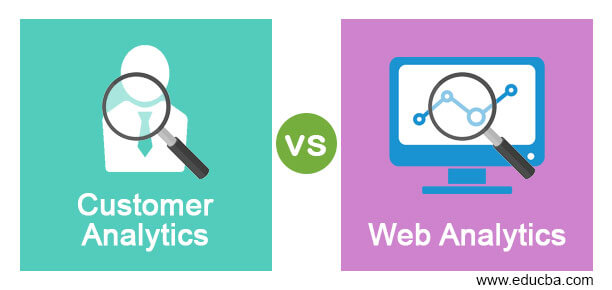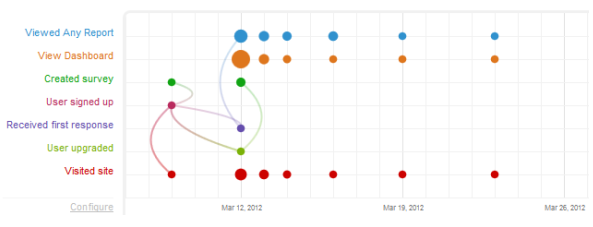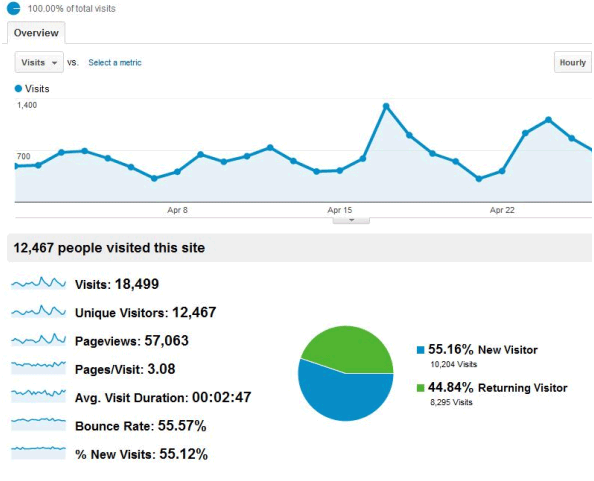Updated June 15, 2023
Difference Between Customer Analytics vs Web Analytics
Customer analytics is also known as the customer data analytics, means the process of identifying the customer information and knowledge which will help you to deliver things that meets out their need. You can also provide timely supply of the relevant product. Customer analytics helps to attract and retain the most profitable customers.
Customer analytics forms the backbone of any marketing activity in a business. It includes techniques such as predictive modelling, data visualization and segmentation.
It is run and managed by different departments like sales, marketing and customer service within an organization.
The objective of it is to gather the accurate view of the customer and provide it to the group so that they can take decisions based on that. They can also decide about the practices to be followed to acquire and retain the customers.
Importance of Customer Analytics
It is becoming critical in every type of business from small scale to large scale. Customers have become more powerful than before and they are also more connected than ever. They have immediate access to information anywhere and at any time. This makes the business to concentrate more on studying about the customers behaviour towards their product or service. This behavioural study will help them to respond to their customers needs more quickly. The better the understanding of the customers and their buying habits, the more accurate will be the future predictions made by the company. Such future predictions will help the business deliver exact product at the right time to the customers.
How customer analytics can help you?
It provides the following advantages to you
- It helps in increasing the response rate by dealing with the right customers, which in turn will increase the Return On Investment (ROI)
- It increases the customers loyalty
- It reduces the marketing costs because it helps you to focus on the customers who are more likely to respond to your ad
- It will reduce the attrition rate
- You can develop proactive campaigns to retain the customers
- It helps to deliver the message to the targeted customers more effectively and efficiently.
How does it look like?
This is the data on individual customer. This shows us clearly where they have come from and often they have visited your site. There is also a timeline report which is shown in the picture below
This timeline will show you the exact action of every single individual with your business. This will tell you what products they have used, what actions they have taken and how often is their action. These data will tell you the story of your customer which in turn will
What is Web Analytics?
Every businessman has now realized the importance of web analytics to their business. It has become a default part of the company’s online toolkit. Having an fully developed and attractive website without any web analytics software programme is totally useless.
Web analytics means the collection and analysis of web data in order to maximize the web usage of the site. Web analytics measures things which are taken into account by webmaster. This includes page loading time, number of views, time spent by the visitor on the site and other factors. Web analytics will help to improve the performance of the site. It also helps to measure the effectiveness of advertisement campaigns. In simple words web analytics is nothing but giving answers to the following questions
- Who is visiting your site ?
- How did they reach your site ?
- What was their behaviour on your site ?
- Where did they go from your site ?
Importance of web analytics
Web analytics are extremely important for a number of reasons. The main reason behind using web analytics is, you can understand the behaviour of your visitors and can use such data to optimize the website more effectively. Below mentioned are few of the reasons why web analytics is important for a business
- Web analytics helps to find out things that are broken on your website
- It helps to track the source of traffic like blogs, links and others
- Web analytics provides data based on which changes are made to the site
- It will help you to improve the online marketing strategies and thereby create more leads to the site
- Web analytics will help to track the kind of data
- It helps to find out which promotion technique works best for your business
- Web analytics helps to plan your marketing strategy, SEO campaigns and design of the website
Information provided by web analytics
Web analytics provides data about the website as well as the visitors. Web analytics programme will give you information on the following
Audience
- Number of visitors on your site
- How many new and how many are returning visitors
- Which part of the country do they belong to
- What is their browser
Audience behaviour
- On which page did they land on your website
- How did they exist your site
- Which pages are more attractive and popular
- How much time they spend on your site
Campaign data
- What marketing campaign was more effective
- Which campaign brought in more visitors to your site
- The keywords searched by the visitor to find your site
Thus web analytics plays a great role in measuring your website.
How web analytics looks like
The picture given below shows a view of the web analytics report to you
The data like this measures every detail about the website. It is not simple analytics, it is web analytics. All the data is available but you need to find out which data among these is useful for your business in the current situation. The most important thing is it is not that easy to find out the data that matters. You need to bring together one or more data to find out what your customer is doing in your site.
You can come to a conclusion only if you spend too much time on web analytics. You should also have experience in behavioural psychology, web design and marketing. You should be able to handle the analytics to get the data you need for your business. Web Analytics also requires lot of time to go through the information until you find a data that is considered worth to act upon.
For web analytics these qualities act as deal breakers. But there is also a better way to do this using variety of web analytics tools. Google analytics is one of the most popular and best web analytics tools used widely by many organizations.
Customer analytics vs Web analytics
Now let’s see what makes customer analytics different from web analytics
-
Customer facing
Web analytics is specially meant for data and product teams. It does not have anything to deal with customer-facing departments.
It include customer-facing department that plays a major role in implementing customer knowledge into action in an organization.
-
Skillset
Web analytics requires special skills for collecting and reporting the data. As a result, only technical users can be benefited.
Customer data analytics does not require any technical skill set. Even a common man can ask questions to the customers and gain knowledge about them.
-
Customer information
Web analytics is not built in such a way to go the individual customer level and find out the information. Because of this it is difficult for web analytics to provide deeper knowledge about a particular customer. And sometimes it also depends on the web analytics tools you are using for your business.
It can give you deeper knowledge about each and every customer of your business. This is because they have direct contact with the customers. It lets you know individual level behavioural data on each customer related to your business.
-
Future predictions
Web analytics cannot predict the future based on the traffic driven to the site or by the number of customers visited the site. It can just tell you whether your marketing efforts are successful or not.
Customer data analytics includes understanding a customer behaviour before contacting them. This behavioural study will let the company to predict the future leads, new customers, references, etc. Such prediction is really helpful for companies who have huge number of customers like B2B, insurance, real estate and others.
-
Support and service teams
Web analytics do not offer any support or service to the customers. It just tracks the data and report it to the business owners.
It has a support and service team who render help to the customers in troubleshooting a problem. The success of support and service team will help in making the customers more satisfied and retain them with the business for a long time.
-
Data
Web analytics focuses on aggregate and anonymous data. For example, the data about traffic to the site does not provide any information about the individual customer. This method works well for some companies.
Customer data analytics takes real customers into account. It focuses on the people who are engaged with your website and product or service.
-
Identification of customers
How many smart phones or tablet do you use now ?
A single person may access the same website from different devices in a single day. Traditional web analytics will consider every access as unique as they were not able to find out that it is the same person logging in from different devices. This served as a great disadvantage for data collection.
But today’s world is hyper connected. Now a day’s customers are comparing the product from more devices before purchasing it. If the analytics fails to identify the same user across different devices then it will result in more inaccurate data.
Customer analytics on the other hand takes into account every single customer of the business as a unique individual. They might access your site from different devices but they are identified as a single user through customer analytics. Because of this there will be accuracy of the data.
-
Tracking standards
Web analytics vendor offers different tracking methods and standards. Business people often feel that the result from one web analytics software programme differs greatly from another web analytics programme. They also face the difficulty of tracking the web analytics programme across different devices.
Customer data analytics programme often follows the same tracking method. The results have only slight variation or no variation.
-
Delivery of information
Customer data analytics programme are created to provide contact and business information to the teams who face the customers directly, such as sales and customer support. It helps the customer facing teams to get the behavioural insight about the customers.
Web analytics programs are created to provide information about the website traffic to the data and marketing teams.
-
Organization of data
Under Web analytics data is organized around the website like page views, landing pages and others.
Under customer analytics data is organized around the customers. Instead of focussing on the website data, if we concentrate more on the customers’ data then the data becomes more easy to control. This is because data on actual people are easy to understand and use. This is the function of customer analytics. In this, every bit of information is related to actual person.
Conclusion
Every business needs to measure and optimize their website as well as their product. Web analytics data helps you to do this thing. However, these numbers should be tied to real-time customers using customer data analytics. But still there is a dominant place for web analytics. Online businesses feel that the impression is more important than the real person. There are also other companies that focus on the customers, the leads and their opportunity. In simple words the success of their customer is considered as their success.
Recommended Articles
This has been a guide to Customer Analytics vs Web Analytics. Here we have discussed the basic concept, how does it looks, along with its importance and differences respectively. You may look at the following articles to learn more –






